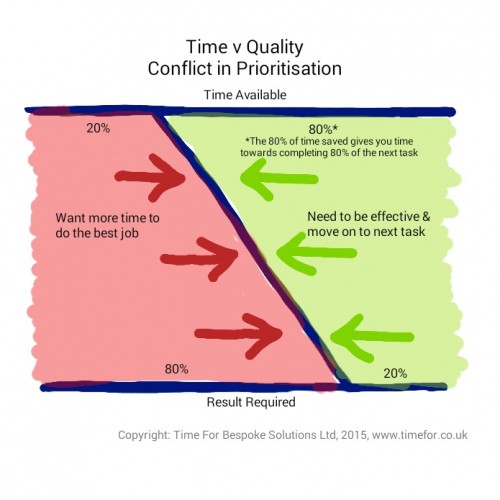In a high pressure environment, when faced with deadlines looming and more work being allocated to you, there is this constant challenge of, “I could do a far better job, if only I had more time”. The reality of these situations usually means that you are under pressure from your manager to get the job completed in order that you can progress onto the next project. It is this very same manager who is going to be disappointed (OK that may very well be an understatement!) if the job is not completed to the required standard.
So, how should you view the use of your time when trying to get through a task? 80/20 is a ratio that gets used quite often in many business related contexts. As an example, when I used to have customer sales panels (when working for Aviva PLC), as a rough rule of thumb it was not unusual to find that almost 80% of the income came from the top 20% of my panel. This was a useful way of considering how best to split my time between my customers (i.e. if I spent 80% of my time with the top 20% of customers, it should have a far more positive impact on the performance overall, as opposed to splitting my time evenly across everyone on the panel).
Another area where I have heard the 80/20 rule being cited is in the time taken to complete tasks. The theory is that you get the bulk of a task progressed relatively quickly (i.e. as high as 80% completed in 20% of the end result time used), and then you spend a much longer period of time working on getting the task finally completed (i.e. as much as 80% of the time to complete the final 20% of the task). Now all of this, in reality, seems a very simplistic way to view your outputs and it is without doubt that the amount of time taken to complete certain tasks, and get the quality right, may very well be warranted. And, of course, we can always debate for any particular project if it is 80/20 or 70/30 or 60/40 etc. The point however is, to bear in mind that whilst you are taking all of this time to improve upon what you have already almost fully completed, it directly conflicts with that same period of time potentially contributing towards up to 80% of the next project that is awaiting your attention. Then, when you break this down even further, all of the potential time slots available to you (if it was decided that you didn’t need everything to be absolutely perfect) could in fact contribute towards the completion of many more tasks. It is therefore quite right to challenge the process by asking, “How much better is the output, bearing in mind the extra time required to get it better?” So keep challenging yourself or your team, as to how much time you really need to get a task completed, but please don’t lose sight of the quality/standards required. Perhaps in some instances you can revisit the quality/standards to see if in any way you are doing things which are beyond what the end user actually needs to fulfill their purposes.

